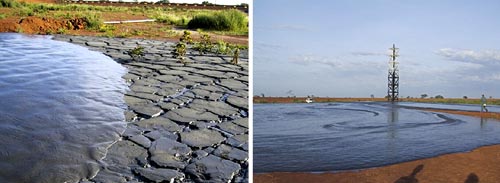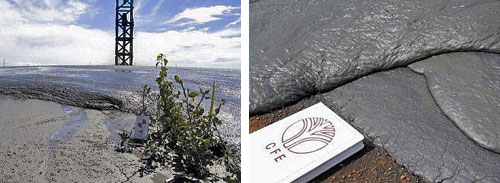Surface Paste Tailings Disposal
Surface Paste Tailings Disposal
Paste tailings are defined as tailings that have been significantly dewatered to a point where they do not have a critical flow velocity when pumped, do not segregate as they deposit and produce minimal (if any) bleed water when discharged from a pipe (figure 1). The increased viscosity of the tailings as a result of high dewatering requires the use of positive displacement pumps to transport the paste. This limits the distance to which the paste can be economically transported (Theriault, Frostiak et al. 2003).

Figure 1: Surface paste disposal at Myra Falls Mine, Vancouver Island, Canada (© Jon Engels)
Surface paste disposal evolved from technology used for the underground backfilling of voids (Welch 2003). As a consequence, dewatering technology has been driven by the demand to produce lower water content tailings which have seen the development of high rate and deep cone thickeners that often have height to diameter ratios of greater than unity (Fourie 2003). Additives such as flocculants and coagulants are usually added to the tailings feed or the thickener to dewater the tailings to higher densities. The types of additives used reflect how the paste behaves when pumped and how the tailings will flow once at the storage facility (Fourie 2003).
Paste is generally deposited like thickened tailings to form a conical pile, which generate typically slope angles of 2 – 10% providing the underlying material has stabilised (Theriault, Frostiak et al. 2003). As the layers of paste cease to flow, desiccation can occur producing cracks. The new overlaying flow fills in the cracks and locks the layers together, forming a more stable structure. Figure 2 shows the flow of the paste over previous layers at the Bulyanhulu Mine in Tanzania.

Figure 2: Fresh paste depositing over a desiccated layer (left) and one of the risers at the Bulyanhulu Mine, Tanzania (Courtesy Golder Associates)
Cost savings from water recovery are the main driver to developing paste storage facilities. On a global scale, surface paste disposal is very rare in the mining industry. At the present time, paste is relatively unproven compared to other methods of surface tailings disposal. However, thickened and paste tailings storage will become more popular particularly as the day to day management aspects are not as intense as conventional storage techniques.
As well as the advantages of thickened tailings storage as discussed in the thickened tailings section here, some additional advantages of paste disposal are:
Paste tailings is sometimes sold as a 'product', rather than the most cost effective solution. A simple trade-off study analysing different forms of tailings storage methodology can determine the capital and operating costs associated with implemented a paste disposal system. Some of the disadvantages to paste tailings are the following:

Figure 3: Fresh paste layers at the Bulyanhulu Mine, Tanzania (Courtesy Golder Associates)
